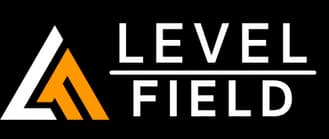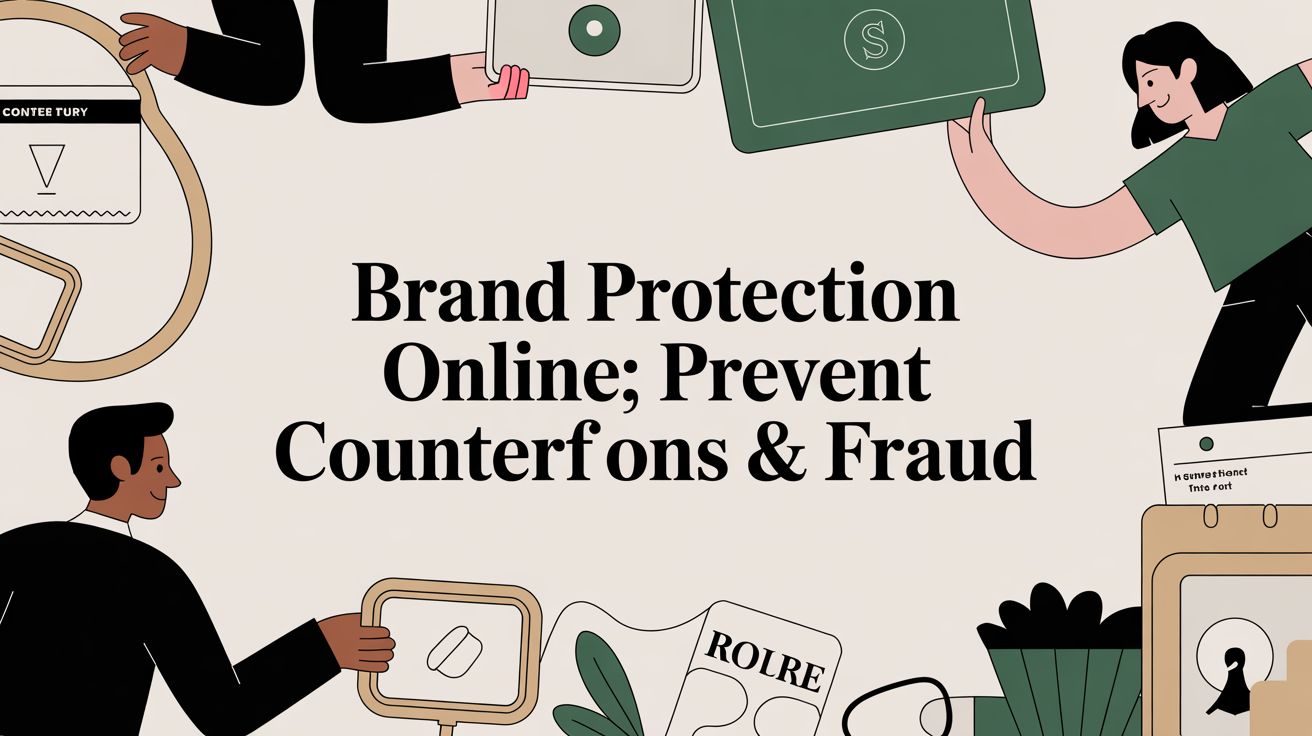
Think of online brand protection as digital security for your company's most valuable asset: its reputation. It’s the ongoing work of finding and shutting down threats like fake products, imposter social media accounts, and scam ads that steal your customers and damage your good name.
It’s less of a one-time task and more like a digital immune system, constantly on the lookout for anything that could harm your business.
What Is Online Brand Protection
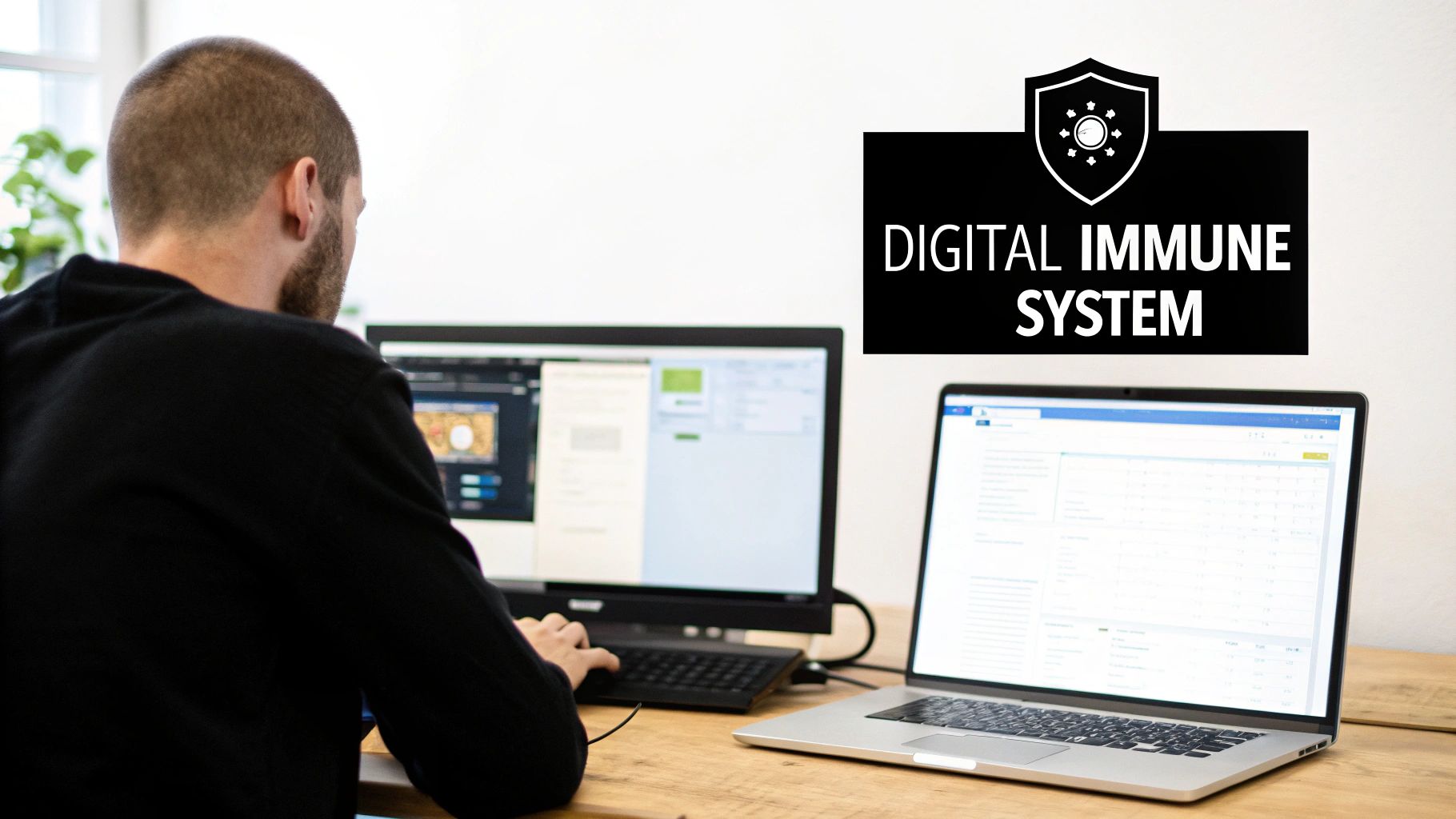
Imagine you own a popular boutique. You'd never let someone open a shoddy counterfeit shop right next door, using your name to trick your customers into buying cheap knockoffs. Online brand protection takes that same common-sense principle and applies it to the vast, chaotic world of the internet.
It’s a strategic, continuous effort. The goal isn’t just to play whack-a-mole with problems as they pop up, but to build a system that anticipates these threats and neutralizes them before they can do real, lasting damage to your revenue and customer relationships.
The Core Components of Brand Protection
An effective brand protection strategy really boils down to three key parts working together. If one of these pillars is weak, the whole structure becomes wobbly and far less effective.
Smart Technology: This is your early warning system. You need automated tools scanning marketplaces, social media platforms, websites, and app stores 24/7 for potential infringements. No human team could ever match the speed and scale of modern monitoring software.
Constant Vigilance: Technology casts a wide net, but it can’t tell the difference between a superfan and a scammer. That’s where human expertise comes in. You need a solid process for people to analyze alerts, confirm which ones are real threats, and decide what to tackle first.
Decisive Action: Finding a threat is only half the battle. You have to move fast to get it taken down. This means knowing how to use each platform's reporting tools, when to send a formal legal notice, and having the persistence to follow up until the problem is gone. If you don't act, you're signaling to bad actors that your brand is an easy target.
A strong brand is built on trust. Every counterfeit product, imposter account, or fraudulent ad chips away at that trust, damaging not only immediate sales but also long-term customer loyalty and brand equity.
Why It's a Business Function, Not Just a Legal One
While brand protection is grounded in legal concepts like trademark and copyright law, thinking of it as purely a legal issue is a huge mistake. Today, it’s a critical business function that impacts nearly every department.
Take a flood of counterfeits on Amazon, for example. That’s not just a legal problem; it directly torpedoes your sales figures and leads to a wave of angry 1-star reviews from customers who thought they bought the real thing. An imposter account on Instagram can derail a million-dollar marketing campaign by spreading false information.
Ultimately, strong brand protection online is about protecting the very engine of your company's growth and stability.
The Top Threats to Your Brand Online
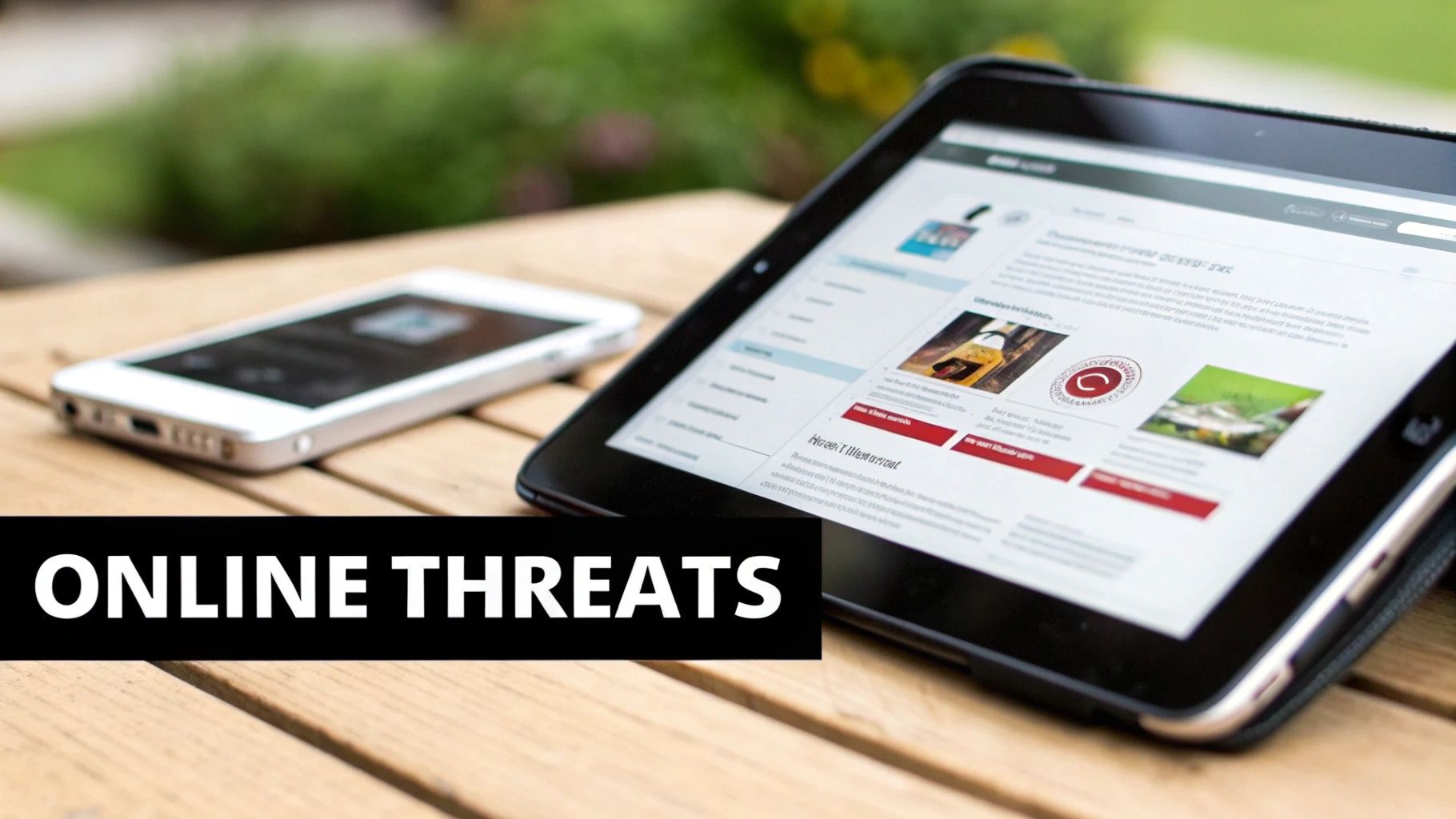
Think of your brand's online presence as your digital storefront. Just like a physical store, it needs protection from some very real threats that can pop up anywhere, anytime. These aren't just minor annoyances; they're direct attacks that can eat into your revenue, erode the trust you've built with customers, and tarnish your reputation for years to come.
The first step in defending your brand is knowing what you're up against. The scale of the problem is genuinely staggering. Projections show that counterfeiting and piracy could drain up to $4.2 trillion from the global economy by 2025. That number isn't just lost sales—it's the massive cost of shattered consumer confidence. In response, the brand protection market is expected to surge past $7.64 billion by 2032 as companies scramble to fight back.
Before we dive into the specific types of threats, here's a quick overview of what most brands are up against.
Common Online Brand Threats and Their Impact
Threat Type | Common Platforms | Primary Business Impact |
|---|---|---|
Counterfeit Listings | Amazon, eBay, Alibaba, Wish | Lost revenue, damaged reputation, product liability risks, poor reviews. |
Brand Impersonation | Instagram, Facebook, X (Twitter), TikTok | Customer data theft (phishing), spreading misinformation, sale of fakes. |
Deceptive Advertising | Google Ads, Bing Ads, Social Media Ads | Traffic hijacking, loss of high-intent customers, brand confusion. |
Phishing & Scam Sites | Fake websites, lookalike domains | Financial loss for customers, compromised credentials, severe trust erosion. |
This table gives you a bird's-eye view, but the real damage happens in the details. Let's break down the most common attacks you're likely to face.
1. Counterfeit Product Listings
This is probably the most direct and damaging threat out there. Bad actors create slick-looking listings on major e-commerce platforms like Amazon, eBay, and Alibaba, pushing knockoff versions of your products. These fakes are almost always made with cheap, substandard materials—and sometimes, they're downright dangerous.
Take, for example, a popular cosmetics brand that discovered counterfeit versions of its best-selling foundation on a major marketplace. When they had the fakes tested, they found unsafe levels of lead and other toxins. The fallout was immediate: customers reported skin reactions, and a flood of one-star reviews tanked the real product's rating.
Dealing with these listings requires a methodical approach. You can learn the right way to get these fakes taken down by reading our comprehensive guide on counterfeit removal.
2. Brand Impersonation on Social Media
Impersonation goes way beyond just copying your logo. Scammers will build entire social media profiles that perfectly mimic your official accounts—using your branding, your tone of voice, and your product shots to fool your audience. They use these fake accounts to run phony promotions, phish for customer data, or just spread chaos and misinformation.
Imagine a fast-growing fashion retailer gearing up for a huge holiday sale. A week before launch, a fake Instagram account pops up, looking identical to their official page. It announces a "pre-sale flash giveaway," tricking hundreds of excited followers into handing over their credit card details to a scam website. The damage is instant. Customers are out of pocket, and the brand's reputation for being a safe place to shop is left in tatters.
Impersonation attacks prey on the trust you've worked so hard to build. A single fake account can undo years of positive community engagement by misleading your most loyal followers.
3. Deceptive Advertising and Traffic Diversion
This one is sneaky. Competitors or outright scammers will use your brand name in paid search ads to mislead people who are actively looking for you. This might involve bidding on your branded keywords to send traffic to their website, or creating ads that promise a discount on your products but lead to a phishing page instead.
This tactic siphons off your best customers—the ones who are literally typing your name into a search bar. A well-known software company discovered a rival was running Google Ads using its exact brand name. The ads pointed to a landing page that looked just similar enough to be confusing, pushing the competitor's inferior product. Before they caught it, they had lost an estimated 20% of their search traffic to this dirty trick.
Each of these threats highlights why a vigilant, proactive approach to brand protection online isn't a luxury; it's a necessity.
How to Build Your Brand Protection Strategy
Building a solid brand protection strategy is like drawing up a battle plan. If you go in without a clear map, you'll end up wasting time and energy on small skirmishes while the real threats cause serious damage. This isn't just theory—it's a practical blueprint for shifting from reactive chaos to proactive control.
A winning strategy always starts with knowing what you’re protecting. The first step is to take a complete inventory of your most valuable digital assets. These are the crown jewels of your brand, the things that, if copied or abused, would hurt you the most.
And you need to think beyond just your company name. Your list of critical assets should be surprisingly detailed.
Identify Your Core Digital Assets
First things first, make a comprehensive list. This isn't just a task for your legal team; it’s a core business exercise. What elements truly define your brand and actually drive revenue?
Your inventory should include:
Registered Trademarks: This is the obvious one—your company name, logos, and key product names that have official legal protection.
Key Product and Service Names: Even if they aren't trademarked, these are the names customers use to find you.
Brand Slogans and Taglines: Those memorable phrases that are instantly associated with your brand and no one else.
Executive Names and Likenesses: The public faces of your company are assets, too, and prime targets for impersonation.
Unique Product Designs: Think of distinctive packaging or product shapes that your customers recognize in a heartbeat.
Once you have this list, you’ve basically drawn the perimeter you need to defend. Getting this clarity is the foundation for everything that follows in brand protection online.
Establish a Robust Monitoring System
With your assets identified, it's time to set up your surveillance network. You need a system that can continuously scan the internet for anyone using your brand elements without permission. You really have two options here, and frankly, the best approach is usually a mix of both.
Doing it manually, like having someone on your team periodically search Amazon or Google, is a fine place to start. But it becomes completely unmanageable as you grow. It's like trying to patrol an entire city on foot—you’ll only ever see a tiny fraction of what's really going on.
Automated software, on the other hand, is your city-wide CCTV system. These tools use AI to scan millions of websites, marketplaces, social media accounts, and ad networks 24/7. They give you the scale and speed you need to catch infringements that would otherwise slip right past you. This kind of always-on monitoring is absolutely essential for a modern defense.
Triage Threats Like an Emergency Room
Monitoring is going to surface a lot of alerts, and they are not all created equal. An angry comment on a blog just isn't the same as a network of websites selling dangerous counterfeits of your top product. This is where a smart triage process becomes your best friend.
Think of your brand protection team as an emergency room. You have to quickly assess each incoming "patient" (the threat) to figure out how severe it is and who needs treatment first. This ensures your most precious resource—your team's time—is spent stopping the most critical bleeding.
A simple but incredibly effective triage system sorts threats by their potential impact on your business.
Your Threat Triage Levels
Critical (Act Immediately): These are the five-alarm fires. They pose an immediate danger to customer safety, revenue, or brand integrity. We're talking about phishing sites stealing credit card data or listings for counterfeit products that could physically harm someone.
High Priority (Act Within 24-48 Hours): These threats are causing direct and significant financial harm but aren't an immediate safety crisis. This bucket includes high-volume counterfeit sellers, major brand impersonation accounts on social media, or ad hijacking campaigns that are stealing your customers right out from under you.
Standard Priority (Weekly Review): This category is for the smaller-scale infringements that you need to address but aren't catastrophic. Think of a single unauthorized seller on eBay with low sales volume or some minor trademark misuse in a blog post.
Monitor (Log and Watch): Some issues just aren't worth immediate action but need to be kept on your radar. This could be a fan account that’s getting a little too close to infringement or a low-traffic website using your logo without asking.
By sorting every single alert into these buckets, you create a structured and scalable workflow. It guarantees your team is always focused on the problems that actually matter, making your brand protection efforts both efficient and truly impactful.
Your Enforcement and Takedown Playbook
Finding a brand infringement online is one thing, but getting it taken down is the real win. This is where you shift from simply watching to taking decisive action. Think of your enforcement playbook as a set of proven, repeatable steps for removing content that hurts your brand, whether it's a counterfeit on Amazon or an imposter on Instagram.
To act with confidence, you need to know your options. Some situations demand a direct legal approach, while others are best handled through the reporting tools built right into the platforms themselves. Knowing which tool to use for the job is half the battle.
This whole process—from discovery to enforcement—is a continuous loop.
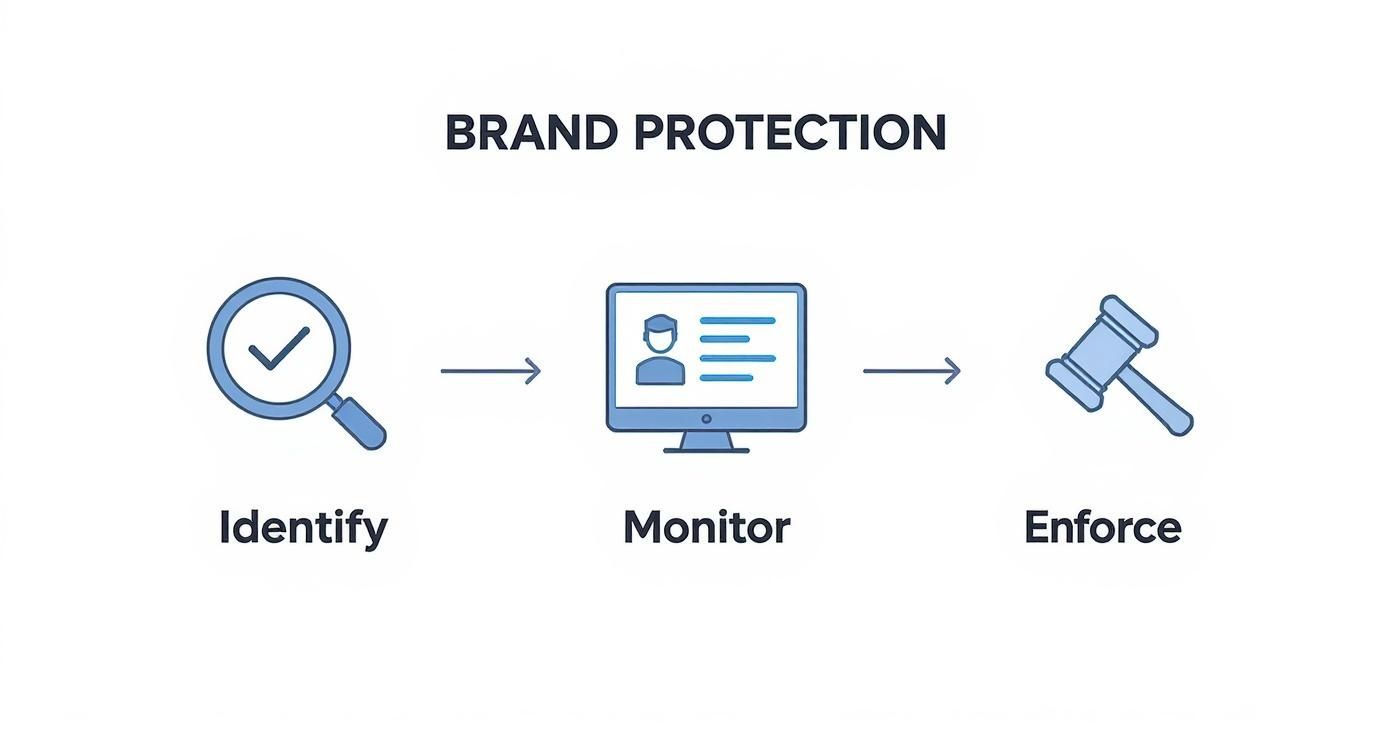
This simple flow drives home a critical point: enforcement is the step that makes all your hard work in identifying and monitoring threats actually pay off.
Choosing Your Enforcement Path
Not all infringements are created equal, and they don't all require the same response. Your first big decision is picking the right channel. You've generally got two main options, each with its own time and place.
Direct Legal Action (Cease and Desist): This is the classic lawyer-drafted letter sent directly to the infringer, demanding they stop their illegal activity. It’s most effective when you know exactly who you're dealing with and the damage they're causing is significant.
Platform-Based Reporting: For most online issues, this is your frontline defense. Platforms like Amazon, Meta (for Facebook and Instagram), and Google have dedicated portals for intellectual property violations. This route is often much faster and more efficient for getting a listing or an account shut down.
Mastering Platform Reporting Tools
Most of the fight for brand protection online happens on the major platforms. They have a real incentive to keep their ecosystems clean and have built specific tools to help you report problems. The secret to success here is giving them the right evidence in the right format.
Before you even think about hitting that "report" button, you need to gather compelling proof.
Essential Evidence for Takedown Requests:
Proof of Ownership: This is non-negotiable. Have your trademark registration numbers handy. For copyright issues, have direct links to your original work ready to go.
Clear Screenshots: Grab images of the infringing listing, account, or ad. Use arrows or highlights to make it painfully obvious what the violation is—like your logo plastered on their fake product.
Direct URLs: You need the exact web address of the problem content. Don't just link to a seller's storefront; link directly to the specific counterfeit product listing.
Explanation of Harm: This is where you connect the dots for the reviewer. Don't just say it's a violation. Briefly explain how it's hurting your brand. For example, "This imposter account is tricking our customers into thinking it's an official support channel," or "This counterfeit is causing negative reviews on our genuine product pages."
A well-documented report is an easy report to approve. The people reviewing these cases are looking for clear, undeniable proof. The more work you do to make their job easy, the faster you’ll get the result you want.
When you're dealing with stolen content, like someone ripping off your product photos or website copy, the DMCA (Digital Millennium Copyright Act) is a powerful tool. Sending a formal notice is a specific legal process, and we break down exactly how to prepare and send a DMCA takedown notice in our dedicated guide.
The Growing Role of Technology in Enforcement
The sheer volume of online threats makes trying to handle enforcement manually a losing battle. This reality has fueled explosive growth in specialized software designed to automate the grunt work.
The online brand protection software market was valued at around USD 0.72 billion in 2024 and is expected to more than double to USD 1.64 billion by 2032. That growth is being driven by AI-powered tools that can automatically spot infringements and fire off takedown requests on marketplaces like Amazon and Alibaba. You can dig into the numbers on this market's expansion at Data Bridge Market Research.
By combining a clear strategy with meticulous evidence, you build a powerful system for defending your brand's reputation and bottom line.
Measuring Success and Proving ROI
So, how do you know if your brand protection efforts are actually paying off? Racking up a high takedown count feels productive, but it doesn't tell the whole story. To get budget approval and show the real value of your work, you need to connect your actions to what the business really cares about: the bottom line.
Think of it this way: effective brand protection online isn't just about playing whack-a-mole with infringers. It’s about generating a tangible return by shifting the focus from raw activity (how many things you took down) to measurable impact (how much revenue you saved and how many customers you protected).
Key Performance Indicators That Actually Matter
Moving beyond a simple takedown tally gives you a much richer, more persuasive story to tell. These are the KPIs that show how your work directly protects revenue and strengthens the brand's reputation.
Reduction Rate of Infringements: This is about showing progress over time. Can you demonstrate a 75% drop in fake listings for your flagship product this quarter compared to last? That’s a stat that gets attention.
Decrease in Fraud-Related Complaints: Your customer service team is on the front lines. Work with them to track complaints about scams, fakes, or phishing attacks. When those ticket numbers go down, you have direct proof that you're shielding real customers from harm.
Monetary Value of Recovered Revenue: This is often the most powerful metric you can present. It's a straightforward calculation based on the infringing goods you get removed. For instance, if you take down 1,000 counterfeit listings for a product that sells for $50, you’ve just protected $50,000 in potential lost sales.
Proving ROI is all about telling a financial story. The narrative isn't just "we removed 500 fake accounts." It's "we protected an estimated $250,000 in revenue and cut customer fraud complaints by 40%, directly safeguarding our brand's long-term value."
How to Calculate Your Brand Protection ROI
Calculating your Return on Investment (ROI) is the clearest way to show stakeholders that brand protection isn't just a cost center—it's a smart investment. While some benefits like brand trust are harder to put a number on, a simple framework can make the financial impact crystal clear.
The basic formula is pretty simple:
(Financial Gain from Investment - Cost of Investment) / Cost of Investment
Let's walk through a real-world example to see how this works.
Example ROI Calculation
Imagine a growing e-commerce brand decides to invest in a brand protection service.
Cost of Investment:
Annual service fee: $12,000
Financial Gain (Benefits):
Recovered Revenue: They successfully removed counterfeit listings with an estimated market value of $80,000.
Reduced Ad Spend Waste: They shut down several ad hijacking campaigns that were stealing an estimated $15,000 worth of their web traffic.
Reduced Support Costs: With fewer customers receiving fakes, support tickets related to fraud dropped, saving an estimated $5,000 in support team hours.
Now, let's plug these numbers into the formula:
Total Financial Gain: $80,000 + $15,000 + $5,000 = $100,000
Net Gain: $100,000 (Gain) - $12,000 (Cost) = $88,000
Calculate ROI: $88,000 / $12,000 = 7.33
To turn that into a percentage, just multiply by 100. The brand saw an ROI of 733%.
This means for every single dollar they invested in brand protection, they got more than seven dollars back in tangible, measurable value. That's the kind of hard data that makes it easy to justify continuing—and even expanding—the program.
When to Partner with a Protection Service
Making the call to handle brand protection in-house or bring in a specialist is a big one. At first, going the DIY route with built-in platform tools seems totally doable. But as your brand gets bigger, the flood of threats can quickly overwhelm your team, turning a manageable task into a frustrating, full-time firefight you can't win.
Knowing when to call for backup is key. There are a few tell-tale signs that it’s time to team up with an expert service. Catching them early means you can act before small problems balloon into major crises that damage your revenue and hard-earned reputation.
Signs It’s Time to Hire an Expert
Is your team spending more time hunting down fake listings than focusing on growing the business? That’s a massive red flag. This usually happens when the sheer number of infringements becomes a tidal wave, making it impossible to keep your head above water.
Here are a few clear indicators that you’ve outgrown your internal setup:
The Volume is Unmanageable: You simply can't get to every threat anymore. You're always a step behind, and fake products are staying online for weeks before you even have a chance to report them.
The Problem Goes Global: The fakes aren't just on one or two marketplaces. Now you’re finding them on platforms in different countries, in different languages, each with its own bizarre set of reporting rules.
Things Get Legally Complicated: You’re dealing with more sophisticated sellers who just ignore a standard takedown notice. Suddenly, you need a legal strategy that’s way outside your team’s wheelhouse.
Case Study: A fashion brand that was blowing up in popularity found itself drowning in thousands of counterfeit listings across various Asian marketplaces. They brought in a specialist service that knew the local landscape. The result? A 90% drop in fraudulent listings in just six months, which immediately helped restore their legitimate sales channels.
The Value of a Specialized Partner
Working with a service is about more than just outsourcing takedowns. It’s like adding a strategic ally to your team—one that comes with powerful tools and years of niche experience. These firms already have relationships with the major platforms and know exactly what evidence to submit to get fakes removed, fast. They bring a level of efficiency and scale that’s almost impossible to build yourself without a huge investment.
This kind of efficiency is why the industry is booming. The global brand protection tools market is expected to jump from USD 3.40 billion in 2025 to USD 7.96 billion by 2035. Much of this growth comes from companies finally embracing automated tools that use AI to spot and shut down threats in real time. You can read more about the rise of brand protection tools on Future Market Insights.
In the end, it really boils down to how you want to spend your resources. If the money you're losing to fakes, a damaged reputation, and your team's divided attention is more than the cost of a professional service, the answer is obvious. A dedicated partner for your brand protection online lets you get back to doing what you do best: building the very brand they're helping you protect.
Frequently Asked Questions
When you start digging into online brand protection, the practical questions pop up pretty fast. Let's tackle some of the most common ones I hear from business owners.
How Much Does Online Brand Protection Cost?
This is a classic "it depends" question, but the answer really hinges on how much you want to handle yourself versus how much you want to offload. Think of it like doing your business's taxes—you can do it yourself, buy software, or hire an accountant.
Here's a breakdown of the typical approaches:
The DIY Route: Getting started can cost you nothing but your time. Setting up Google Alerts for your brand and product names is a free, simple way to create a basic tripwire for potential issues. It’s a great first step, but be prepared for a lot of manual sifting.
Software-Only Tools: The next level up involves dedicated software platforms. These usually run anywhere from a few hundred to several thousand dollars a month. They give you a powerful dashboard to monitor for threats automatically, but your team is still on the hook for investigating alerts and handling the takedowns.
Full-Service Protection: When you need a complete solution, you partner with a specialized service like LevelField. We handle everything from discovery to enforcement. This approach is custom-fit to your brand's specific problems, turning brand protection into a predictable investment with a clear, measurable impact on your bottom line.
Can a Small Business Really Protect Its Brand Online?
Yes, 100%. You don't need a massive budget to make a real difference. The trick for a small business is to be strategic and pick your battles.
First things first: lock down your core assets. Get your primary brand name and logo registered as trademarks. This piece of paper is your golden ticket—it's the legal foundation for almost every enforcement action you'll take.
After that, focus on where you make your money. If you sell on your own website, your top priority should be taking down copycat sites and fake ads that steal your customers. If Amazon is your main channel, focus your efforts there.
For a small business, brand protection isn't about chasing down every single violation on the internet. It's about surgically removing the threats that directly harm your revenue and reputation.
What Is the First Step I Should Take Today?
If you do just one thing, start the trademark registration process. Seriously. Having a registered trademark is the single most powerful tool you can have. Without it, you’re fighting with one hand tied behind your back on most online platforms.
While that's in motion, set up some basic monitoring. Create those free Google Alerts I mentioned for your company name, your product names, and maybe even your CEO's name. It’s a simple early-warning system that can tip you off to a problem before it gets out of hand.
Taking these two steps immediately shifts you from being a passive target to an active defender of your brand.
